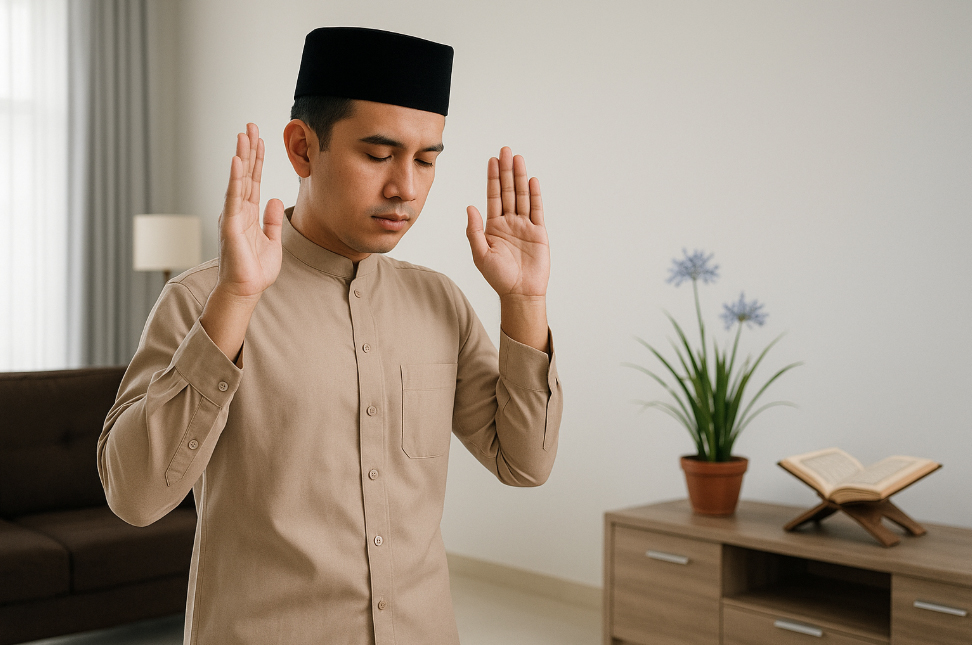Question
Should we raise our hands in prayer (raf‘ al-yadayn)? At what points in Salah did the Prophet ﷺ raise his hands, and is it necessary to do so?
Bottom Line
With or without your salah is valid.
Quick Answer
Yes, the Prophet ﷺ consistently raised his hands in Salah: 1. When starting the prayer (takbir al-ihram) 2. Before bowing (ruku‘) 3. When rising from ruku‘ 4. When standing after the first tashahhud
The authentic reports on this outweigh the weak narrations that suggest otherwise. Scholars agree it is a Sunnah, not a requirement.
Key Takeaway
- The Prophet ﷺ raised his hands at four points in prayer.
- Hadiths against raising the hands are weak and not relied upon.
- Most scholars consider it Sunnah and highly recommended.
- Neglecting it does not invalidate the prayer, but practicing it makes the prayer closer to the Sunnah.
Detailed Answer
The practice of *raf‘ al-yadayn* is well established in the Sunnah.
Abdullah ibn Umar (RA) reported:
“The Messenger of Allah ﷺ used to raise his hands to shoulder level when he started to pray, when he said ‘Allahu akbar’ before bowing in ruku‘, and when he raised his head from ruku‘.”
Some narrations claimed the Prophet ﷺ only raised his hands at the start of prayer. Examples include hadith from al-Bara’ ibn Azib Abu Dawud 749 and Abdullah ibn Mas‘ud Abu Dawud 748. However, major hadith scholars — including Imam al-Bukhari, Ahmad ibn Hanbal, and Ibn Hajar — judged these narrations weak.
Imam al-Bukhari even dedicated a book (Juz’ fi Raf‘ al-Yadayn) proving that all the Companions practiced raising their hands, and he strongly rejected claims to the contrary.
Therefore, the reliable Sunnah is to raise the hands at the four moments mentioned above. This follows the Prophet’s ﷺ instruction:
“Pray as you have seen me praying.”
Scholarly Balance
Some scholars, such as those in the Hanafi school, did not emphasize raising the hands except at the start of Salah. They based this on ijtihad and reports available to them. They are to be respected and excused, as the Prophet ﷺ said:
“If a judge strives to reach a decision and is correct, he has two rewards. If he strives and makes a mistake, he has one reward.”
Still, once the authentic Sunnah is clear, the majority of scholars affirm that reviving it is more beloved to Allah.
What This Means for You
Raising the hands in prayer is not compulsory, but it is an authentic Sunnah that brings your prayer closer to the way the Prophet ﷺ prayed. If you practice it, you gain a reward and align yourself with His Sunnah. If you leave it, your prayer remains valid.
And Allah knows best.
References
Primary Sources
Qur’an
- Al-Ahzab 33:21: The Prophet ﷺ is the best example to follow.
Hadith
- Sahih al-Bukhari 735, Sahih Muslim 390: Ibn `Umar narrates that the Prophet ﷺ raised his hands at ruku‘ and rising from ruku‘.
- Sahih al-Bukhari 631: “Pray as you have seen me praying.”
- Sunan Abi Dawud 749: al-Bara’ ibn `Azib narrates raising hands only once (weak).
- Sunan Abi Dawud 748: Ibn Mas‘ud narrates raising hands only once (weak).
- Sahih al-Bukhari 7352, Sahih Muslim 1716: Ijtihad and reward for judges.
Secondary Sources
- Imam al-Bukhari, Juz’ fi Raf‘ al-Yadayn: Dedicated treatise on raising the hands.
- Imam al-Nawawi, Al-Majmu‘ 3/399–406: Summary of scholarly opinions on raf‘ al-yadayn.
- Ibn Hajar al-‘Asqalani, Talkhis al-Habir 1/221–223: Weakness of hadith against raising hands.
- Ibn Taymiyyah, Raf‘ al-Malam ‘an al-A’immat al-A‘lam: On excusing scholars who differed.
Was this helpful?
Leave Your Comments
© Copyright 2025, All Rights Reserved

